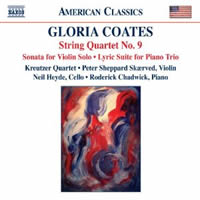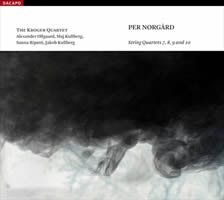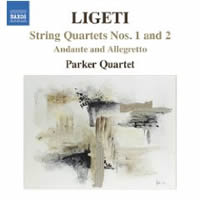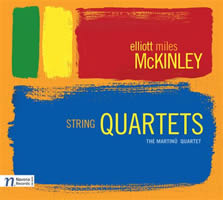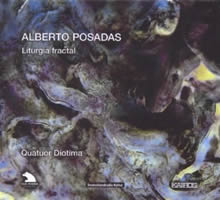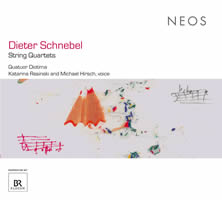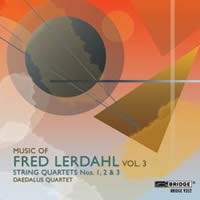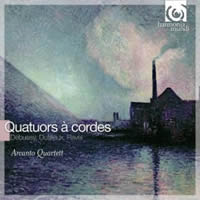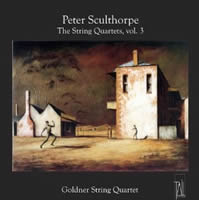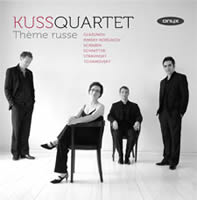String Theory 7: 32 Quartets, etc.
|
Grant Chu Covell [May 2012.]
Gloria COATES: String Quartet No. 9 (2007); Sonata for Violin Solo (2000); Lyric Suite for Piano Trio, “Split the Lark — and you’ll find the Music” (1996). Kreutzer Quartet: Peter Sheppard Skærved, Mihailo Tandafilovski (vlns), Morgan Goff (vla), Neil Heyde (vlc); Roderick Chadwick (pno). Naxos 8.559666 (1 CD) (http://www.naxos.com/). Naxos’ third installment of Coates’ quartets delivers what appears to be her most recent quartet. As expected, the Ninth’s two movements slither atmospherically through microtones and glissandos, upending slow canons. The companion works retreat in time, as we see Coates’ quest for a pure style. The Piano Trio may start from Emily Dickinson poems and hover distractedly across hymns, but the detuned violin creates a haze that warms and singes. The solo violin sonata charts a course through four movements. Of course Bach dwells in the background, but Coates adds dissonance and out-of-step harmony.
Per NØRGÅRD: String Quartet No. 7 (1993-04); String Quartet No. 8, “Night Descending Like Smoke” (1995-97); String Quartet No. 9, “Into the Source” (2000-01); String Quartet No. 10, “Harvest Timeless” (2005). The Kroger Quartet: Alexander Øllgaard, Maj Kullberg (vlns), Sanna Ripatti (vla), Jakob Kullberg (vlc). Dacapo 8.226059 (1 CD) (http://www.dacapo-records.dk/). Distributed in the US by Naxos (http://www.naxos.com/). Unpredictable as cascading water, Nørgård’s latest quartets are tight and efficient. Now and again a tonal phrase might glimmer only to be squashed by violence, singing, a string retuning, or a cessation. There are microtones in the Seventh’s central movement and the Eighth’s opening. Folks in the know will recognize melody and structure derived from Nørgård’s infinity series. The Kroger Quartet captures these works’ remarkable vitality.
György LIGETI: String Quartet No. 1, “Metamorphoses nocturnes” (1953-54); String Quartet No. 2 (1968); Andante and Allegretto (1950). Parker Quartet: Daniel Chong, Karen Kim (vlns), Jessica Bodner (vla), Kee-Hyun Kim (vlc). Naxos 8.570781 (1 CD) (http://www.naxos.com/). Ligeti made his mark on the 20th century, yet his chamber music has little currency. The First was born in Hungary and reveals deep understanding of Bartók’s quartets, music he knew only from score as performances were banned. The Parker looks past the grit and embraces Ligeti’s confidence in the medium. The Second arrived several years after Atmosphères and just before the Chamber Concerto, and clothes various Ligeti concerns including perpetual motion and abrupt texture changes. The two movements from 1950 serve as footnotes, revealing yet another easygoing non-modern composer from the century’s start.
Elliott Miles McKINLEY: String Quartet No. 4 (2001)1; String Quartet No. 5 (2005)2; String Quartet No. 6 (2010)3. The Martinů Quartet: Lubomír Havlák1,2,3, Petr Matěják1,2, Irena Herajnová3 (vlns), Jan Jíša1,2, Zbyněk Paďourek3 (vla), Jitka Vlašánková1,2,3 (vlc). Navona Records NV 5855 (1 enhanced CD with scores and notes) (http://www.navonarecords.com/). Son of William Thomas, Elliott Miles (named for Mr. Carter and Mr. Davis?) offers three jazz-infused quartets. Hardly an insecure genre bender à la Piazzolla, McKinley has found a vocabulary that suggests Gershwin and Ellington, and even Berg, at their most inquisitive. Nos. 4 and 5 demonstrate simple mechanics: short movements with melodies over backgrounds. No. 6 takes a welcome turn towards expansive darkness with surprises. Recordings were made shortly after each quartet was completed. The Martinů lineup shifted for No. 6 and appears to have changed yet again.
“Liturgia fractal.” Alberto POSADAS: Ondulado tiempo sonoro… (2003); Modulaciones (2006); Órbitas (2007); Arborescencias (2007); Bifurcaciones (2007). Quatuor Diotima: Naaman Sluchin, Yun-Peng Zhao (vlns), Franck Chevalier (vla), Pierre Morlet (vlc). Kairos 0012932KAI (1 CD) (http://www.kairos-music.com/). Distributed in the US by Allegro Music (http://www.allegro-music.com/). Posadas’ five-part string quartet cycle derives its essence from fractals. Both Ondulado tiempo sonoro… and Modulaciones employ Brownian motion, with the latter also requiring various mutes for softer textures. Órbitas uses the Mandelbrot set. Arborescencias divides the quartet into solo violin supported with string trio and can be extracted from this cycle. Bifurcaciones’ algorithm simulates the human circulatory system. While the notes provide insights into Posadas’ methods, it’s best simply to listen as the music churns to hidden whims. Posadas studied with Francisco Guerrero, which may explain similarities with Zayin.
Dieter SCHNEBEL: Streichquartett “Im Raum” (2005-06); Stücke (1954-55); 2. Streichquartett, “Erinnern — Widerholen — Durcharbeiten” (2000-07). Quatuor Diotima: Naaman Sluchin, Yun-Peng Zhao (vlns), Franck Chevalier (vla), Pierre Morlet (vlc); Katarina Rasinski, Michael Hirsch (voices). NEOS 11048 (1 SACD) (http://www.neos-music.com/). “In space” requires its players to stamp and move about, in addition to performing a kitchen sink’s worth of extended techniques. Instead of special effects, Schnebel treads the standard four-movement quartet form to elicit aftereffects. Allusions to the literature are discarded like paper napkins. The Adagio stumbles across Bruckner and the Tristan chord drops here and there. Schnebel’s later career involves teasing apart conventions, and so the mid-century five Pieces couldn’t contrast more given their super-serial nature where every pitch appears but once in each miniature. Commissioned for the International Psychoanalytical Association’s 45th annual congress and named for Freud’s essay, the Second adds words (speaking musicians or, as here, actors). Numbers, conjunctions and assorted syllables flitter above abraded gestures. If the First was a string-quartet aftermath, the Second suggests that we cut our memories loose before entropy swallows us whole. Neos captures everything and the Diotima sounds superb.
“Music of Fred Lerdahl, Vol. 3.” Fred LERDAHL: String Quartet No. 1 (1978, rev. 2008); String Quartet No. 2 (1982, rev. 2009-10); String Quartet No. 3 (2008). Daedalus Quartet: Min-Young Kim, Ara Gregorian (vlns), Jessica Thompson (vla), Raman Ramakrishnan (vlc). Bridge 9352 (1 CD) (http://www.bridgerecords.com/). Equal durations obscure this trilogy’s larger structural relationships. Repeated listening reveals successively lengthening variations in a spiraling form: No. 1 contains 15, with two in No. 2, and just one in No. 3. Intertwined structure aside, the continuously evolving material blurs any variations’ boundaries. Chords and rhythms accrue threads and streams. Daedalus bristles with energy which Bridge sets in fine relief.
Claude DEBUSSY: String Quartet, Op. 10 (1892-93). Henri DUTILLEUX: Ainsi la nuit (1971-76). Maurice RAVEL: Quatuor à cordes (1902-03). Arcanto Quartett: Antje Weithaas, Daniel Sepec (vlns), Tabea Zimmermann (vla), Jean-Guihen Queyras (vlc). Harmonia Mundi HMC 902067 (1 CD) (http://www.harmoniamundi.com/). The Arcanto permits mentioning an all-time favorite, the marvelous Dutilleux quartet. Recall that LP durations’ forced many Debussy-Ravel marriages. Longer CDs now embrace the pair’s descendant. Despite the jazzy and whole-tone innovations, Debussy’s Quartet anchors to traditional forms. Eugène Ysaÿe’s quartet premiered Debussy’s only work to bear an opus number. Ravel’s Quartet leaves me cold compared to Debussy’s invigorating Op. 10. Insistent, frugal, but not ungenerous, Dutilleux’s multi-panel masterpiece invites repeating as chords and gestures realign. I welcome any excuse to revisit Ainsi la nuit and the Accanto rewards the journey.
“Complete String Quartets Vol. 3.” Peter SCULTHORPE: String Quartet No. 14, “Quamby” (1998); String Quartet No. 15 (1999); String Quartet No. 16 (2005); String Quartet No. 17 (2007). Goldner String Quartet: Dene Olding, Dimity Hall (vlns), Irina Morozova (vla), Julian Smiles (vlc). Tall Poppiess TP206 (1 CD) (http://www.tallpoppies.net/). With works that span a decade, Tall Poppies offers a third volume of Sculthorpe’s quartets to celebrate the composer’s 80th. Sculthorpe’s music inhabits places I will probably never visit. Profoundly proud of his Australian influences, Sculthorpe’s softened modernity admits more European citations such as Beethoven, quoted in No. 14 and the lightweight No. 17. For the most part, Australian lore inspires genial tunes over modal accompaniments. Quamby refers to a region in Tasmania but may have been the despairing cries of persecuted natives. There are aggressive glints in No. 15 which includes an exorcism among songs for dancing, mourning and the like. No. 16 offers Anger and Trauma, incorporates tunes from Central Afghanistan and is the most intense of these four. Nos. 14, 15 and 16 include startling glissandos which mimic wailing birds.
“Thème Russe.” Var comps.: Variations on a Russian folk song for string quartet (1898). Pyotr Ilyich TCHAIKOVSKY: selections from Album for the Young, Op. 39 (1878, arr. Rostislav DUBINSKY); String Quartet No. 1, Op. 11 (1865). Igor STRAVINSKY: Concertino (1920). Alfred SCHNITTKE: Canon in memoriam Igor Stravinsky (1971-76). Kuss Quartet: Jana Kuss, Oliver Willie (vlns), William Coleman (vla), Mikayel Hakhnazaryan (vlc). Onyx 4090 (1 CD) (http://www.onyxclassics.com/). Distributed in the US by Harmonia Mundi (http://www.harmoniamundi.com/). This superb disc reminds us that the Russian string quartet had a curtailed childhood. Western influences would persist until the modern age, and even when native composers incorporated ethnic melodies they did so with an outsider’s agenda. We have no Russian Haydn or Beethoven, nor even an Arriaga. Tchaikovsky set the Romantic stage, with Shostakovich towering over the lot. The Kuss Quartet wraps Tchaikovsky around the other pieces, creating an oasis for the short Stravinsky and Schnittke. The Op. 39 potboilers charm when configured for quartet. [This last was arranged by the first violinist of the Borodin Quartet, 1946-75. W.M.]
Coates, Debussy, Dubinsky, Dutilleux, EM McKinley, Lerdahl, Ligeti, Nørgård, Posadas, Ravel, Schnebel, Schnittke, Sculthorpe, Stravinsky, Tchaikovsky
[More
Coates, Debussy, Dubinsky, Dutilleux, EM McKinley, Lerdahl, Ligeti, Nørgård, Posadas, Ravel, Schnebel, Schnittke, Sculthorpe, Stravinsky, Tchaikovsky]
[Previous Article:
Piano Factory 8. (D. 840)]
[Next Article:
Americans]
|
